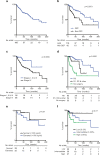Chilean Registry for Neuroendocrine Tumors: A Latin American Perspective
- PMID: 30465145
- PMCID: PMC6334732
- DOI: 10.1007/s12672-018-0354-5
Chilean Registry for Neuroendocrine Tumors: A Latin American Perspective
Abstract
Neuroendocrine tumors (NETs) are relatively rare and highly heterogeneous neoplasms. Despite this, recent studies from North America and Central Europe have suggested an increase in incidence. In Latin America, NET data are scarce and scattered with only a few studies reporting registries. Our goal was to establish a NET registry in Chile. Here, we report the establishment and our first 166 NET patients. We observed a slight preponderance of males, a median age at diagnosis of 53 years and a median overall survival of 110 months. As anticipated, most tumors were gastroenteropancreatic (GEP). Survival analyses demonstrated that non-GEP or stage IV tumors presented significantly lower overall survival (OS). Similarly, patients with surgery classified as R0 had better OS compared to R1, R2, or no surgery. Furthermore, patients with elevated chromogranin A (CgA) or high Ki67 showed a trend to poorer OS; however, these differences did not reach statistical significance (log-rank test p = 0.07). To the best of our knowledge, this is the first report of a NET registry in Chile. Median OS in our registry (110 months) is in line with other registries from Argentina and Spain. Other variables including age at diagnosis and gender were similar to previous studies; however, our data indicate a high proportion of small-bowel NETs compared to other cohorts, reflecting the need for NET regional registries. Indeed, these registries may explain regional discrepancies in incidence and distribution, adding to our knowledge on this seemingly rare, highly heterogeneous disease.
Keywords: Cancer registry; Chromogranin A; Neuroendocrine tumors; Overall survival.
Figures

Similar articles
-
A Consensus-Developed Morphological Re-Evaluation of 196 High-Grade Gastroenteropancreatic Neuroendocrine Neoplasms and Its Clinical Correlations.Neuroendocrinology. 2021;111(9):883-894. doi: 10.1159/000511905. Epub 2020 Oct 1. Neuroendocrinology. 2021. PMID: 33002892
-
Incidence Trends of Gastroenteropancreatic Neuroendocrine Tumors in the United States.Clin Gastroenterol Hepatol. 2019 Oct;17(11):2212-2217.e1. doi: 10.1016/j.cgh.2018.12.017. Epub 2018 Dec 20. Clin Gastroenterol Hepatol. 2019. PMID: 30580091
-
Survival of Patients With Gastroenteropancreatic Neuroendocrine Tumors and Diabetes Mellitus.Pancreas. 2021 Oct 1;50(9):1293-1297. doi: 10.1097/MPA.0000000000001911. Pancreas. 2021. PMID: 34860814 Free PMC article.
-
Incidence, patterns of care and prognostic factors for outcome of gastroenteropancreatic neuroendocrine tumors (GEP-NETs): results from the National Cancer Registry of Spain (RGETNE).Ann Oncol. 2010 Sep;21(9):1794-1803. doi: 10.1093/annonc/mdq022. Epub 2010 Feb 5. Ann Oncol. 2010. PMID: 20139156 Review.
-
Epidemiology, Incidence, and Prevalence of Neuroendocrine Neoplasms: Are There Global Differences?Curr Oncol Rep. 2021 Mar 14;23(4):43. doi: 10.1007/s11912-021-01029-7. Curr Oncol Rep. 2021. PMID: 33719003 Free PMC article. Review.
Cited by
-
Providing Evidence: Step by Step-a Letter from Associate Editor, Tobias Else, MD.Horm Cancer. 2019 Feb;10(1):1-2. doi: 10.1007/s12672-018-0355-4. Horm Cancer. 2019. PMID: 30535924 Free PMC article. No abstract available.
-
Serine and one-carbon metabolisms bring new therapeutic venues in prostate cancer.Discov Oncol. 2021 Oct 27;12(1):45. doi: 10.1007/s12672-021-00440-7. Discov Oncol. 2021. PMID: 35201488 Free PMC article. Review.
-
Neuroendocrine Tumors: An Analysis of Prevalence, Incidence, and Survival in a Hospital-Based Study in Ecuador.Healthcare (Basel). 2022 Aug 18;10(8):1569. doi: 10.3390/healthcare10081569. Healthcare (Basel). 2022. PMID: 36011226 Free PMC article.
-
Impact of sex differences on patients with neuroendocrine neoplasms during hospital admission.Ther Adv Med Oncol. 2024 Dec 15;16:17588359241292271. doi: 10.1177/17588359241292271. eCollection 2024. Ther Adv Med Oncol. 2024. PMID: 39687054 Free PMC article.
-
Understanding p53 tumour suppressor network.Biol Direct. 2021 Aug 6;16(1):14. doi: 10.1186/s13062-021-00298-3. Biol Direct. 2021. PMID: 34362419 Free PMC article.
References
-
- Yao JC, Hassan M, Phan A, Dagohoy C, Leary C, Mares JE, Abdalla EK, Fleming JB, Vauthey JN, Rashid A, Evans DB. One hundred years after “carcinoid”: epidemiology of and prognostic factors for neuroendocrine tumors in 35,825 cases in the United States. J Clin Oncol. 2008;26:3063–3072. doi: 10.1200/JCO.2007.15.4377. - DOI - PubMed
-
- Garcia-Carbonero R, Capdevila J, Crespo-Herrero G, Diaz-Perez JA, Martinez del Prado MP, Alonso Orduna V, Sevilla-Garcia I, Villabona-Artero C, Beguiristain-Gomez A, Llanos-Munoz M, Marazuela M, Alvarez-Escola C, Castellano D, Vilar E, Jimenez-Fonseca P, Teule A, Sastre-Valera J, Benavent-Vinuelas M, Monleon A, Salazar R. Incidence, patterns of care and prognostic factors for outcome of gastroenteropancreatic neuroendocrine tumors (GEP-NETs): results from the National Cancer Registry of Spain (RGETNE) Ann Oncol. 2010;21:1794–1803. doi: 10.1093/annonc/mdq022. - DOI - PubMed
Publication types
MeSH terms
Substances
Supplementary concepts
Grants and funding
LinkOut - more resources
Full Text Sources
Research Materials

